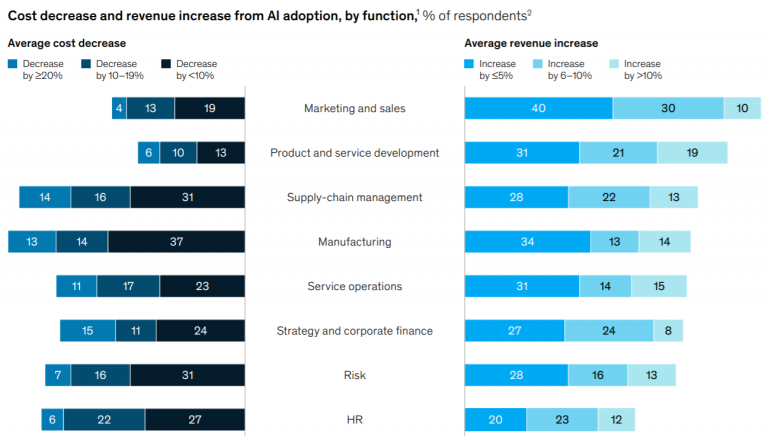We first heard the concept of AI from Alan Turing during the Second World War, then with the Millenium new opportunities come and suddenly it becomes something that we couldn’t stop talking! But how it is affecting business life? And how much companies know about it? In November 2019 McKinsey Analytics made a Global AI Survey to understand what business thinks about AI. For this survey, they asked participants about 33 use cases in 8 different business functions and how each of these activities has influenced their cost and revenue. And their findings are way different than what many people think.
Recipients Happy to See the Return and Value Delivered By AI
63 percent of respondents said that their revenue increases from AI and report their revenue gains of more than 10 percent. Especially in the marketing and sales department, companies that use AI in pricing, prediction of likelihood to buy, and customer-service analytics can see the meaningful value by AI. This followed by product and service development, supply-chain management and manufacturing. However, this rate is much smaller in HR than in other departments. From the data above we can say AI adaptation increasing all industries, but competence alters. High tech is the leader of AI but in general, we can see that industries use this technology more admissible to their value chain. Retail has seen the largest increase with 60 percent. Respondents saying their companies have ingrained at least one AI capability in one or more functions or business units, a %35 increase in revenue. And this is not just US-based. On a regional level, the survey shows compelling increases in adoption levels in developed Asia– Pacific, Europe, Latin America, and North America. %74 of the companies who already adopted AI says that in 3 years we will see more AI adaptation on organizations.
What Are the Risks?
Before adopting AI, a survey shows us that %41 of the organization identified the risk of it. Companies who know the risk are most likely to concerns about cybersecurity and regulatory compliance. From the employee perspective; workforce reduction is a key problem. Well, it depends on the industry. For example, automotive and assembly, are more likely to report a workforce reduction. But in general, the survey shows us 3/1 of respondents report less than a 3 percent change in their companies’ workforce size. However in the next 3 years; %34 of the respondents say that adaptation of AI drives a decrease in the number of employees. Exclusively employment levels in HR, manufacturing, supply-chain management, and service operations areas. Even though this seems like a problem to employees, we all know that every technology brings opportunities in employment. For some industries; the survey showed us job increases of 3 percent after adopting AI.
The survey results indicate that some companies are further ahead in realizing AI’s impact, and the other ones need to catch up immediately if they want to survive.









